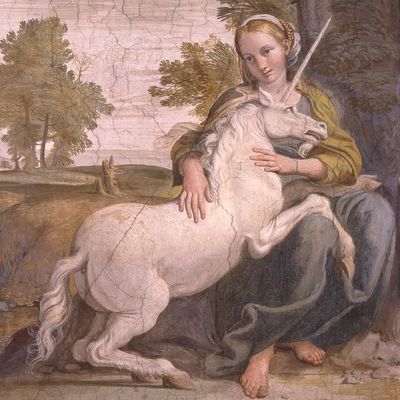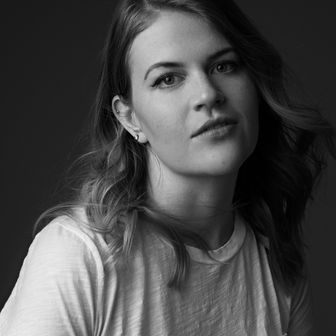
They’re on bags, T-shirts, key chains, pillows, humidifiers. They’re in frappuccinos, noodles, ice cream. We make movies about them, and TV shows, and toys. Children love them. Adults love them. Channing Tatum and Pete Davidson love them. Some of us even pretend to eat their excrement.
People, in short, are absolutely obsessed with unicorns, and have been for a very long time, as Atlantic science editor Sarah Laskow writes in her new illustrated children’s book, The Very Short, Entirely True History of Unicorns. Last week, the Cut spoke to Laskow about why the myth of horses with a horn on their head has persisted for so long and across so many cultures, why narwhals are cool as hell, and even disclosed some of the more PG-13 unicorn facts that didn’t make the book.
The Cut: What made you want to write a book about unicorns in the first place?
Sarah Laskow: It started off as a slightly different idea. I had read something — I’m actually not sure if it’s true or not — about how there might have actually been fire-breathing lizards that inspired the idea of dragons. And the idea was that these certain types of lizards exhale methane, and if they had gotten too close to a fire, their breath would have caught on fire, and that’s where people got the idea of dragons from.
That was the germ of the idea, to write a factual book about a fantasy creature. And from there it just evolved to be a little more about history, and we decided to do unicorns instead of dragons, because unicorns are so fun and interesting. There’s much history there to talk about, so much real, actual, factual ways that people have talked about these creatures and thought about these creatures.
One of the things that stood out the most to me when reading it is how myths of this single-horned creature existed all around the world in all these different cultures.
It’s really incredible, right? That you have people all over the world coming up with this same idea that we know is fictional. I think it’s because it’s really plausible. The idea of a four-legged creature that has one horn is just slightly orthogonal to the reality that you see every day. There’s tons of creatures with two horns, there’s tons of four-legged creatures and there are creatures out there that have only one horn. So it takes a little bit of imagination, but not a ton of imagination.
It also seems like people got really creative with it. You write about one that had a horse’s body and elephant feet and the head of a stag and a long black horn and was just a mishmash of all these different creatures. People threw everything in there.
Totally. I think my favorite one is the Zoroastrian mythical one that had one horn but also six eyes and three feet and just the wrong number of everything. There was a funny detail that didn’t make it into the book, because it’s a book that’s meant for kids, but it was also supposed to have a very large number of testicles. I think, like, five? That one was a real triumph of imagination.
When you were writing this, was your life consumed by unicorns? Were you constantly pulling out unicorn facts with friends?
Yeah. A lot of my free time was spent thinking about unicorns, and people started giving me little unicorn objects. My mom got me this great unicorn key chain that is a unicorn with a button that when you push it, it lights up and makes some sort of sparkly magic noise. And I was really excited about narwhals. I wanted to talk to everyone about narwhals for a while, because they’re so cool. It was fun to do the book because I went on a little field trip to the Cloisters to see the unicorn tapestries and the narwhal horn they have there. So it was a little bit all-consuming for a while.
I just saw a narwhal horn for the first time recently, and it was so enormous and cool.
Right! They’re so big! There’s at least one example of a historical description of a unicorn that says the unicorn had a horn that was ten feet long. And you have to think that that person had seen a narwhal horn, because that’s how big they are. The one at the Cloisters is way taller than me. And to think that some creature is just swimming around the ocean with that attached to its face? It just makes the world seem like that much more of an incredible place. And that’s what’s cool about this book is that unicorns are magical and fun to think about, but there are actually amazing creatures and amazing things out in the world, like narwhals swimming around with ten-foot horns.
It is really wild that a unicorn isn’t real but a narwhal is. A horse with a horn makes way more sense than a whale with a horn.
That’s exactly it. In some ways it’s easier to imagine this mythical creature than to imagine a lot of creatures that actually existed. It goes back to these historical accounts from Greek and Roman travelers. They would come back with these stories of all of these outlandish creatures, and some of them were real; some of them were elephants and rhinoceroses. So why wouldn’t unicorns be real?
It seems that for a long time, unicorns have been connected to the idea of femininity. Little girls are often portrayed as being into unicorns. Why do you think that is?
It goes back to this medieval lore around unicorns. Again, this is stuff that I didn’t quite delve into in the book because of the age group it’s meant for, but a bunch of the lore about unicorns and maidens in medieval times is about virginity and purity and sexuality. It starts with these ideas about how you catch a unicorn, and a lot of the lore says that you need a virgin, and the unicorn will be attracted to the virgin. Then — it gets pretty explicit — the maiden should grasp the unicorn’s horn, and while she’s touching the horn, that’s when you kill it.
Oh.
Yeah. So I think that’s the original connection between young women and unicorns was this weird — I don’t know if it was a metaphor, but this way of talking about forbidden sexuality. And then over time it gets more and more sanitized, and it’s like, oh yeah, unicorns and young girls are a natural pairing. But it does have its origins in these older, medieval ideas.





